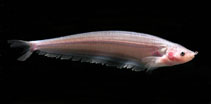http://www.fishbase.org/Summary/speciesSummary.php?genusname=Ceratoglanis&speciesname=pachynema ---> http://52.67.158.155/Summary/speciesSummary.php?genusname=Ceratoglanis&speciesname=pachynema
http://52.67.158.155/Summary/speciesSummary.php?genusname=Ceratoglanis&speciesname=pachynema ---> https://fishbase.net.br/Summary/speciesSummary.php?genusname=Ceratoglanis&speciesname=pachynema
https://fishbase.net.br/Summary/speciesSummary.php?genusname=Ceratoglanis&speciesname=pachynema ---> https://fishbase.net.br/summary/Ceratoglanis-pachynema.html
Ceratoglanis pachynema, Club-barbel sheatfish

You can
sponsor
this page
Common name (e.g. trout)
Genus + Species (e.g. Gadus morhua)
-

-
About this page
-
Languages
-
User feedbacks
-
Citation
-
Uploads
-
Related species
-


 Club-barbel sheatfish
Upload your
photos
and
videos
Club-barbel sheatfish
Upload your
photos
and
videos
Pictures
|
Google image
 Ceratoglanis pachynema
Ceratoglanis pachynema
Picture by
Panitvong, N.
Teleostei (teleosts) >
Siluriformes
(Catfishes) >
Siluridae
(Sheatfishes)
Etymology:
Ceratoglanis:
Greek, keras, -atos = horn + Greek, glanis = a fish that can eat the bait without touching the hook; a cat fish (Ref.
45335
)
;
pachynema:
From
pachys
, Greek for thick and
nema
, Greek for thread, in reference to the thickened maxillary barbels of mature males.
.
Environment: milieu / climate zone / depth range / distribution range
Ecology
Freshwater; demersal. Tropical
Asia: Chao Phraya and Mekong drainages. Previously misidentified as
Ceratoglanis scleronema
from the Chao Phraya drainage.
Size / Weight / Age
Maturity: L
m
?
range ? - ? cm
Max length : 28.0 cm SL male/unsexed; (Ref.
43281
)
Short description
Morphology
|
Morphometrics
Dorsal
spines
(total): 0;
Dorsal
soft rays
(total): 0;
Anal
soft rays
: 90 - 101;
Vertebrae
: 63 - 64. Snout with a gently sloping ventral profile (ventral angle of snout 40°-42°), relatively fewer anal-fin rays (90-101), and larger eyes (eye diameter 13.0-16.4% HL) set closer together (interorbital distance 33.7-36.6% HL). Mature males have membranous extensions on both the anterior and posterior edges of the maxillary barbel. Pectoral spine and articulated segments sexually dimorphic in mature individuals. Males with spine broad and somewhat flattened dorsoventrally, with 10 distinct posterior serrate, increasing in size distally; proximal articulated segments with 17 well-developed posterior serrae; distal-most segments have smaller serrae. Females or juveniles with spine slender and without serrae; proximal articulated segments with 6 minute posterior serrae; distal segments with 5 minute serrae (Ref.
38651
). Absence of dorsal fin; short stiff hooked maxillary barbels; posterior nostril above front margin eye (Ref.
43281
).
Inhabits mainstream river. Carnivorous, feeding on insects and benthic fauna (Ref.
58784
).
Life cycle and mating behavior
Maturity
|
Reproduction
|
Spawning
|
Eggs
|
Fecundity
|
Larvae
Ng, H.H.
, 1999. A review of the Southeast Asian catfish genus
Ceratoglanis
(Siluriformes: Siluridae), with the description of a new species from Thailand. Proc. Calif. Acad. Sci. 51(9):385-395. (Ref.
38651
)
IUCN Red List Status (Ref.
130435
)
Critically Endangered (CR)
(A2e); Date assessed:
23 February 2011
CITES
Not Evaluated
Not Evaluated
Threat to humans
Harmless
Human uses
FAO - Publication:
search
|
FishSource
|
More information
Countries
FAO areas
Ecosystems
Occurrences
Introductions
Stocks
Ecology
Diet
Food items
Food consumption
Ration
Common names
Synonyms
Metabolism
Predators
Ecotoxicology
Reproduction
Maturity
Spawning
Spawning aggregation
Fecundity
Eggs
Egg development
Age/Size
Growth
Length-weight
Length-length
Length-frequencies
Morphometrics
Morphology
Larvae
Larval dynamics
Recruitment
Abundance
BRUVS
References
Aquaculture
Aquaculture profile
Strains
Genetics
Electrophoreses
Heritability
Diseases
Processing
Nutrients
Mass conversion
Collaborators
Pictures
Stamps, Coins Misc.
Sounds
Ciguatera
Speed
Swim. type
Gill area
Otoliths
Brains
Vision
Tools
E-book
|
Field guide
|
Length-frequency wizard
|
Life-history tool
|
Point map
|
Classification Tree
|
Catch-MSY
|
Special reports
Check for Aquarium maintenance
|
Check for Species Fact Sheets
|
Check for Aquaculture Fact Sheets
Download XML
Summary page
|
Point data
|
Common names
|
Photos
Internet sources
AFORO (otoliths) |
Aquatic Commons
|
BHL
|
Cloffa
|
BOLDSystems
|
Websites from users
|
Check FishWatcher
|
CISTI
|
Catalog of Fishes
:
genus
,
species
|
DiscoverLife
|
ECOTOX
| FAO - Publication:
search
|
Faunafri
| Fishipedia |
Fishtrace
| GenBank:
genome
,
nucleotide
| GloBI |
Google Books
|
Google Scholar
|
Google
| IGFA World Record |
MitoFish
|
Otolith Atlas of Taiwan Fishes
|
PubMed
| Reef Life Survey | Socotra Atlas |
Tree of Life
| Wikipedia:
Go
,
Search
| World Records Freshwater Fishing |
Zoobank
|
Zoological Record
Estimates based on models
Phylogenetic diversity index (Ref.
82804
): PD
50
= 0.7500 [Uniqueness, from 0.5 = low to 2.0 = high].
Bayesian length-weight: a=0.00562 (0.00278 - 0.01137), b=3.00 (2.83 - 3.17), in cm total length, based on LWR estimates for this (Sub)family-body shape (Ref.
93245
).
Trophic level (Ref.
69278
): 3.9 ±0.7 se; based on size and trophs of closest relatives
Resilience (Ref.
120179
): Medium, minimum population doubling time 1.4 - 4.4 years (Preliminary K or Fecundity.).
Fishing Vulnerability (Ref.
59153
): Low vulnerability (24 of 100).
Back to Search
Random Species
Back to Top
Accessed through:
Not available
FishBase mirror site :
Laguna, Philippines
Page last modified by :
mrius-barile
|